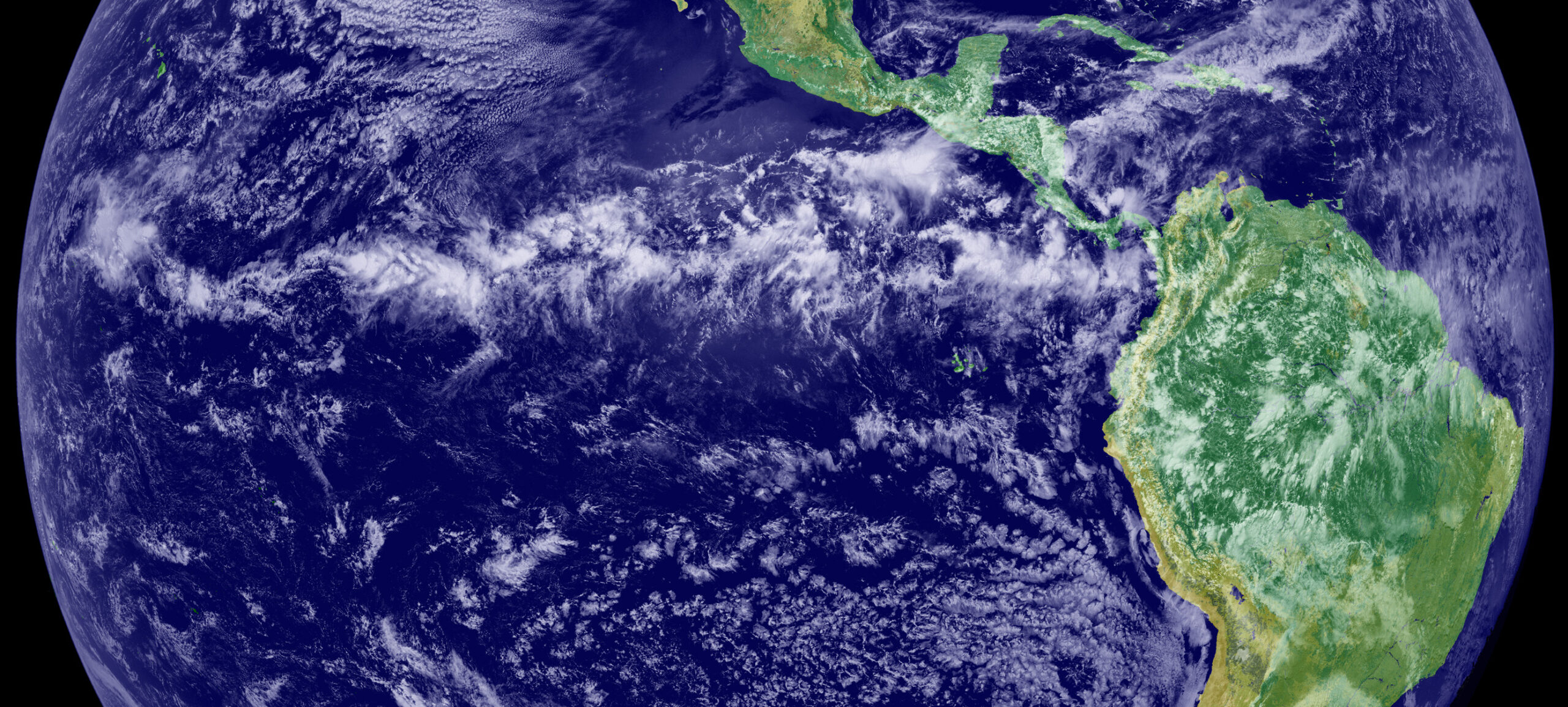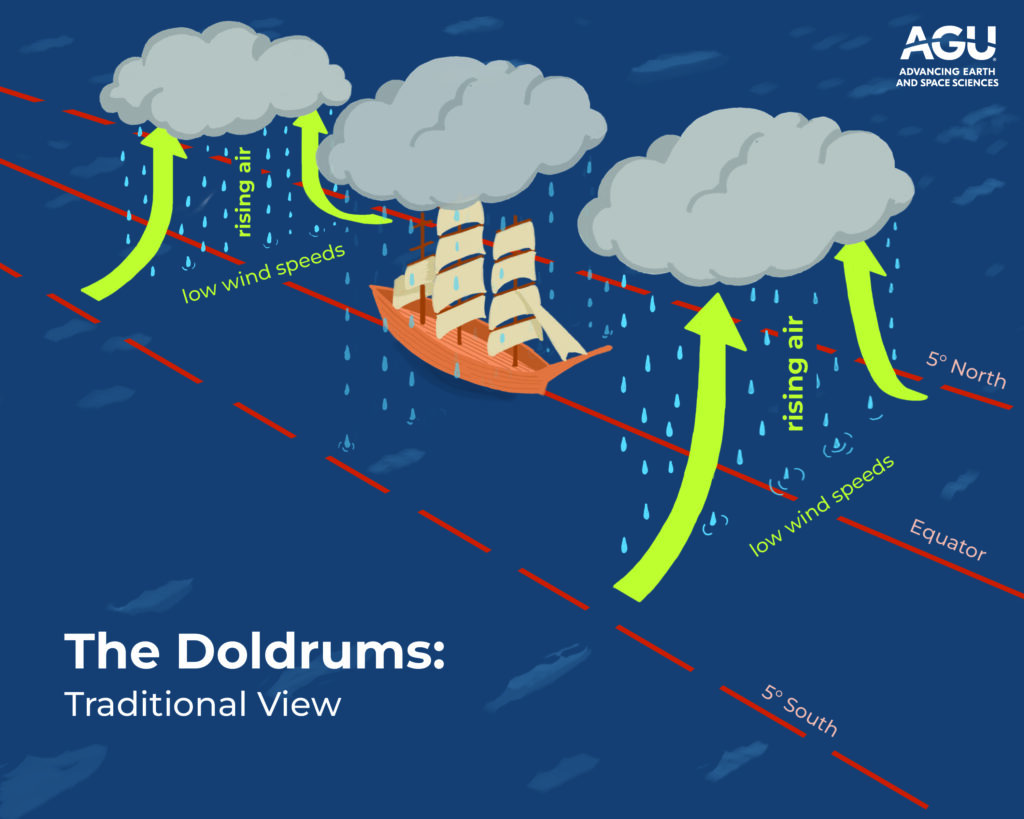A new study overturns a textbook explanation for the low wind speeds that tormented sailing ships in the tropics.
9 September 2024

The Intertropical Convergence Zone encircles the Earth and is often characterized by uplift and storms, but low winds in the region are caused by large regions of sinking air, according to new research in Geophysical Research Letters. Credit: NASA
Researcher contact information:
Julia Windmiller, Max Planck Institute for Meteorology, [email protected] (UTC-1 hours)
- Note: the author is currently on a field campaign investigating the doldrums in the eastern Atlantic. Please email her directly for her availability.
AGU press contact information:
Liza Lester, +1 (202) 777-7494, [email protected] (UTC-5 hours)
WASHINGTON — During the Age of Sail, sailors riding the trade winds past the equator dreaded becoming stranded in the doldrums, a meteorologically distinct region in the deep tropics. For at least a century, scientists have thought that the doldrums’ lack of wind was caused by converging and rising air masses. Now, new research suggests that the opposite may be true.
“The idea of what causes the doldrums came from a time where we didn’t know a lot about how air actually moves in the tropics,” said Julia Windmiller, an atmospheric scientist at the Max Planck Institute for Meteorology and the study’s author. “We have forgotten about the doldrums to such a degree that nobody has taken the trouble of thinking through this original argument again.”
Instead, Windmiller proposes that low wind speeds throughout the doldrums are created by large areas of sinking air that diverge at the surface, creating clear and windless days. Her explanation challenges the conventional explanation for the tropical, oceanic phenomenon that has stranded sailors, inspired poets and largely slipped out of the scientific literature.
Traditionally, areas of low to no wind around the equator have been explained by converging and rising air masses. And while those air masses do create low-pressure, slow-wind areas at the surface, that idea can only explain the doldrums’ extended regions of low winds when many areas of convergence are averaged together over days or weeks. On the shorter timescales, converging air masses do not cover enough area to create large windless regions that can last for days — the doldrums.
The research was published in Geophysical Research Letters, an open-access AGU journal that publishes high-impact, short-format reports with immediate implications spanning all Earth and space sciences.

Very weak surface winds resulted in this mirror-like Atlantic Ocean, captured from the German research vessel Maria S. Merian in February 2024. The deep convective clouds on the horizon mark both the edge of the low-wind region and the southern edge of the Atlantic Intertropical Convergence Zone. Credit: Julian Wagenhofer
Deciphering the doldrums
The doldrums, also known as the Intertropical Convergence Zone, was named by early 19th century sailors marooned at sea by bouts of little or no wind. The term, originally defined as a period of despondency or depression, has come to describe the sometimes-stormy, sometimes-calm equatorial region. The oceanic area was even referenced in Samuel Taylor Coleridge’s 1834 poem, “The Rime of the Ancient Mariner”:
Day after day, day after day,
We stuck, nor breath nor motion;
As idle as a painted ship
Upon a painted ocean.
The Intertropical Convergence Zone is usually characterized as a region of converging trade winds and rising air masses near the equator. The air masses, warmed by equatorial heat, float up like balloons, form clouds and whip up storms over the equator. They then sink back down at approximately 30 degrees North and South of the equator, completing what is known as Hadley Cell circulation. This pattern of converging and rising air near the equator has traditionally been accepted as the cause for the doldrums, as pockets of low to no winds are generally created under rising air masses.
However, little modern research has focused on proving the root cause of the doldrums. The accepted explanation for the doldrums could not be completely correct, Windmiller said, unless the regions of uplifting air were averaged over time.
“There’s this fascinating break in reasoning because this upward circulation of air doesn’t work for short time scales and large areas of still wind,” said Windmiller. “To some degree, because we’ve historically forgotten about the doldrums, this flaw in the logic never really came up.”
Windmiller analyzed Intertropical Convergence Zone meteorological data for the Atlantic Ocean between 2001 and 2021 and buoy data ranging from 1998 to 2018 to define the edges of the Intertropical Convergence Zone and investigate low wind speed events in the region. Low wind speed events are characterized by winds blowing slower than three meters per second, or five knots, for at least six hours. Windmiller examined the data on multi-day, hourly and minute-by-minute timescales, and considered how the low wind speed events evolved over time.
She found that low wind speed events coincided with clear weather conditions, lowered air temperatures and a lack of precipitation: conditions that point to sinking air masses diverging at the surface rather than rising air masses. Windmiller also found that low wind speed events mainly happen in the inner regions of the Intertropical Convergence Zone, and that they only occur on average in about 5% of the region at any given time (but can occur as often as 21% of the time in the eastern Atlantic during the Northern Hemisphere’s summer). Low wind speed locations also varied based on the season and region of the Atlantic Ocean.

The traditional explanation of the doldrums is that rising air near the equator causes storms and regions of low-to-no wind speeds at the surface. Although the doldrums typically occur between 5 degrees North and South of the equator, those boundaries can shift considerably around the tropics. Credit: AGU (CC-BY-ND)

Windmiller’s explanation of the doldrums is that large regions of sinking air near the equator causes long-lasting regions of low-to-no wind speeds at the surface. Although the doldrums typically occur between 5 degrees North and South of the equator, those boundaries can shift considerably around the tropics. Credit: AGU (CC-BY-ND)
“Most of the air inside the Intertropical Convergence Zone is actually going down rather than up,” said Windmiller. “It’s not just on average that we have low wind speeds in this region, but that we have these moments in time when the wind has just gone away over very large areas.”
Her idea is supported not just by scientific evidence, but by the next verse in Coleridge’s poem, which famously describes a ship’s stranding in a windless, rainless region within the doldrums:
Water, water, every where,
And all the boards did shrink;
Water, water, every where,
Nor any drop to drink.
Upending an old explanation
For years, Windmiller has queried other atmospheric scientists about the doldrums: What really causes the wind to occasionally disappear around the equator?
“They would start to explain this upward circulation of air, but as they were explaining it, they often realized it didn’t actually make sense,” said Windmiller. “I was always surprised. It’s such a basic phenomenon, so why wouldn’t we have a theory for it?”
Some questions do remain. Windmiller is not certain what causes the Intertropical Convergence Zone’s large regions of sinking air. While most of the air in the tropics is slowly sinking, that effect alone may not be strong enough to cause the doldrums. Other possible causes include large convective systems that leave downdrafts in their wakes, or humidity gradients that cause local air to cool and sink, she said.
And while modern mariners are unlikely to be stranded in the doldrums thanks to diesel engines, understanding the doldrums’ true cause could still have present-day impacts. New, high-resolution climate models struggle to simulate regions of low wind speeds, so better understanding the doldrums could improve model predictions of precipitation and wind patterns.
“We can no longer explain these low wind speed events in the way we’ve done before,” said Windmiller. “I hope that this is something that people will see and read, and realize that the explanation is really upside down from what we’ve had.”
###
Notes for journalists:
This study is published in Geophysical Research Letters with open access. Neither the paper nor this press release is under embargo. View and download a pdf of the study.
Paper title:
“The calm and variable inner life of the Atlantic Intertropical Convergence Zone: the relationship between the doldrums and surface convergence”
Authors:
- Julia Windmiller, Max Planck Institute for Meteorology, Hamburg, Germany
AGU (www.agu.org) is a global community supporting more than half a million advocates and professionals in Earth and space sciences. Through broad and inclusive partnerships, AGU aims to advance discovery and solution science that accelerate knowledge and create solutions that are ethical, unbiased and respectful of communities and their values. Our programs include serving as a scholarly publisher, convening virtual and in-person events and providing career support. We live our values in everything we do, such as our net zero energy renovated building in Washington, D.C. and our Ethics and Equity Center, which fosters a diverse and inclusive geoscience community to ensure responsible conduct.
Contributed by Madeline Reinsel